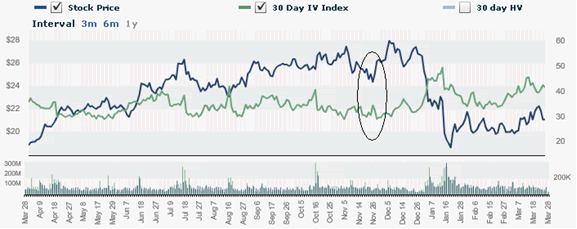Calendar Spreads Definition � Options Explained � optionMONSTER
Post on: 13 Апрель, 2015 No Comment

Calendar spreads provide known and fixed maximum loss up, until the expiration of the short option.
They are usually used with low implied volatility and the expectation of range-bound trade.
Call calendars are virtually identical to put calendars, when using the same strike.
They take advantage of the difference in time decay for different expirations (theta).
Would you like to.
- Be able to profit from range-bound markets?
- Take advantage of the different time decay rates in different expiration months?
Anyone who has traded options for a while has a feel for how time decay can eat away at an option’s value, especially as expiration gets closer. Options positions can in fact profit from time decay, but this entails selling options and can involve significant risk. Long calendar spreads provide a limited-risk way to take advantage of time decay inherent in different expiration dates.
Long calendar spreads profit within a given range. They profit from a rise in implied volatility and are therefore a low-cost way of taking advantage of low implied volatility options. This is considered a more advanced options strategy, but usually has lower risk and a better probability of profit than outright call or put buying.
The maximum risk is known from the outset of the trade, and is equal to the debit paid for the spread, up until the near-month option that you sell gets to expiration, at which point exposure becomes the risk inherent in the option you buy.
What is a Calendar Spread?
Calendar spreads can be done with calls or puts and, if using the same strikes, put and call calendar spreads are virtually equivalent. Implementing the strategy involves buying one option and selling another option of the same type and strike, but with different expiration. A long calendar spread would entail buying an option (not a front month contract) and selling a nearer-expiration option of the same strike and type. Long calendar spreads are traded for a debit, meaning you pay to open the overall position.
This strategy profits in a limited range around the strike used. The trade can be set up with a bullish, bearish or neutral bias. The greatest profit will come when the underlying is at the strike used at expiration. Calendar spreads also profit from a rise in implied volatility, since the long option has a higher vega than the short option.
Calendar spreads lose if the underlying moves too far in either direction. The maximum loss is the debit paid, up until the option you sold expires. After that, you are long an option and your further risk is the entire value of that option.
Options in nearer-month expirations have more time decay than later months (they have a higher theta). The calendar spread profits from this difference in decay rates. This trade is best used when implied volatility is low and when there is implied volatility skew between the months used, specifically when the near-month sold has a higher implied volatility than the later-month bought.
In this example, with the stock at 135.13, the September 135 call is purchased for $15.45, and the July 135 call is sold for $10.45, for a net debit of $5, which is the maximum risk.
This is a neutral trade used when the outlook is for a range-bound underlying. The maximum risk is known from the outset of the trade, and is equal to the debit paid (until the first expiration). If the implied volatility does not change, the position profits from roughly 121 to 154. Rises in implied volatility will increase the profit and the range. Time decay is on your side with this trade.
Example of a Winning Trade
- Research in Motion (RIMM) moved up to $108 in late February, while implied volatility moved down below 50.
Example of a Losing Trade
- Using the same RIMM charts, we see that establishing a spread just before earnings would not have worked out.
Options involve risk and are not suitable for all investors. For more information, please read the Characteristics and Risks of Standardized Options. Copies may be obtained from The Options Clearing Corporation, One North Wacker Drive, Suite 500, Chicago, IL 60606 or call 1-888-OPTIONS or visit www.888options.com.
This material is being provided to you for educational purposes only. This information neither is, nor should be construed, as an offer, or a solicitation of an offer, to buy or sell securities by OptionMonster Holdings. OptionMonster Holdings does not offer or provide any investment advice or opinion regarding the nature, potential, value, suitability or profitability of any particular investment or investment strategy, and you shall be fully responsible for any investment decisions you make, and such decisions will be based solely on your evaluation of your financial circumstances, investment objectives, risk tolerance, and liquidity needs.














